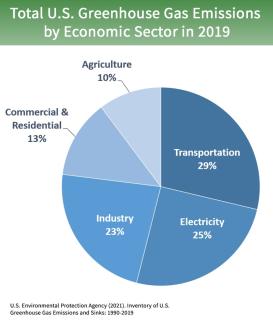Advertisement
Transportation generates 29 percent of all U.S. greenhouse gas emissions, meaning any serious work to mitigate harm from global warming requires changing how we move people and goods.
And while our personal transportation choices matter, significant emission reductions must also involve large-scale institutional change.
Learn more about UUA climate justice work and resources.
Owning more than 200,000 vehicles, of which 70 percent are 25–32 years old, the U.S. Postal Service is poised to make decisions with global impact. Local delivery trucks typically travel less than 100 miles daily at lower speeds, making them perfect candidates for electric engines. The situation creates a once-in-a-generation opportunity to increase efficiency, reduce pollution, and advance economies of scale for electric vehicle production.

Source: US Environmental Protection Agency (2021)
Just one problem: Postmaster General Louis DeJoy awarded a decade-long, multi-billion-dollar contract for those replacements to Oshkosh Defense Corporation. If that sounds to you like a company focused on making armored war machines rather than street vehicles, you’re correct. The plan calls for 90 percent of new trucks to run on gas and travel 8.6 miles per gallon, barely improving their predecessors.
While President Biden has called for all federal vehicle purchases to be emission-free by 2035, he lacks the authority to control or fire the postmaster directly. Biden has appointed most of the USPS Board of Governors, but his selections seem likely to give DeJoy full autonomy. As you may recall, DeJoy gained notoriety by taking hundreds of mail sorting machines out of service just before the 2020 elections and slowed mail service s dramatically.
In a February 6 statement, DeJoy cited budget deficits he inherited as the obstacle to buying more costly electric vehicles. Though USPS is a public service, it is expected to fund itself without direct federal assistance. Yet Congress imposes onerous requirements on USPS to pre-fund employee retirement benefits far into the future, contributing to its deficit. This week, a bill to relieve that burden is moving through Congress, potentially saving USPS $50 billion over the next decade.
If the bill passes, the opportunity should not be wasted. The gas-powered trucks are, indeed, cheaper to purchase. Still, lower operating and maintenance costs for electric trucks start saving money immediately, and full fleet electrification could save $4.3 billion (PDF) over a generation of vehicles.
Notably, Biden’s Build Back Better bill, defeated via Senate filibuster, would have fully funded a USPS transition to electric vehicles.
Upon learning of the USPS procurement plan, the Environmental Protection Agency wrote to USPS urging reconsideration. It claims the decision was based on faulty analysis, including absurd assumptions about battery and gasoline prices. The letter also accused the USPS of illegally awarding $482 million to Oshkosh Inc. before an environmental review.
The dispute also exposed a dangerous EPA rules loophole that incentivizes bigger, more polluting trucks. For example, vehicles classified as light trucks (combined vehicle weight + payload up to 8,500 pounds) must meet significant efficiency requirements from which heavy trucks (exceeding 8,500 pounds) are exempt. The Oshkosh /DeJoy agreement calls for vehicles with a combined vehicle weight of 8,501 pounds—nearly double the weight of most current USPS vehicles, to evade EPA standards.
USPS estimates $3.3 billion would cover a complete transition to electric vehicles. For reference, Congress allotted $24 billion more than anyone requested for “defense” spending. Surely we can afford the relatively modest investment to defend against climate calamity the Pentagon cites as a top security threat.
While we should urge our representatives to enable that crucial step, this conflict should inspire us to look at the procurement choices being made close to home by our schools, local governments, and other institutions we can influence directly. Respecting the interdependent web of our existence on earth is a principle we must strive to fulfill as conscious human beings. Our individual choices as consumers matter. But only through our actions as citizens can we drive change on the scale our climate crisis demands.
Jeff welcomes your criticism, questions, and commentary. Tweet @JMilchen.
